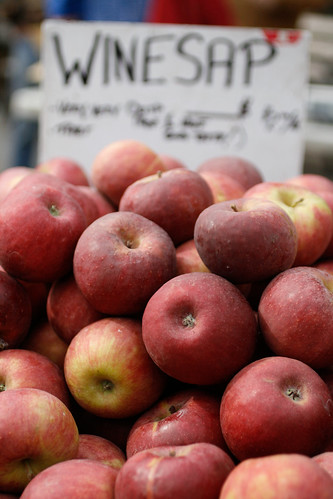
I forgot to mention my new years resolutions....
- Make cooking and cooked foods a luxury (but also luxurious).
- Find more good beer.
- Climb more ladders.
- And; therefore, eat more apples??? Winesaps Please!!!
- Make more films- lots more.
- Scare myself sometimes.
"Why Winesap?" You might ask... given that there are about 2,500 varieties of apples grown in the United State alone, some are obviously suited to one persons taste better that another, some suited to certain applications better than another, and some more ablely produced at certain times unlike another....otherwise there would be fewer apple varieties. Since there are so many apples and the consumer has the right to choose their consumables (within the realm of what is presented as "the consumables"-allow me to add this) what are apples to some are oranges to another. I am from the Northeastern U.S. and take great pride in my area, it is beautiful and delicious. Most local and native foods are the staple of my diet; Kale, Squash, Lettuce, Potatos, corn, carrots, peanut butter, pickled food, hearty grains, good hoppy beer, first and foremost apples. So here goes my argument for the apple of my desire.
This apple was first developed in 1866 by Dr. Joseph Stayman of Leavenworth, Kansas, right on the western banks of the Missouri River in the Northeastern corner of the state. Producers like to coin this as an "antique" or "19th century" apple, an heirloom variety. Where this apple grows best; the minimum temperature averaging above -20 F, perfect for areas prone to early frost, good levels of constant rainfall, ripening in mid October requiring about 170 days for full maturity. The skin is prone to imperfections because it reacts to the environment, therefore it is a discouraged product for new large scale commercial production. Though it was once a largely distributed grocery store item, it has since disappeared from the produce isle and has been replaced by prettier, sweeter, more genetically altered fruit stuff that are just not as good. This is a winning feature of the Winesap because of the dangers of mass production of food commodities... bigger, "better", faster, cheaper which it will not identify with.
The apple itself is fantastic and robust. It is medium to large in size and remains firm and crisp if stored properly (the difference between a fruit cellar and a basement or pantry). The skin is a deep violet red with some greens and yellows, depending on the sub-variety. The flesh is white and crisp with just the right tartness and a sweetness that emulates the sensation of a dry spicy red wine, hence the name Winesap. It is perfect for baking, making apple butter, pressed ciders, and eating raw (with peanut butter= perfect raw meal any day and for me, I would eat it every day if it were possible). It could be eaten at all times of the year! It is a beautiful fruit, first thought of as a signature "dessert variety" and now found in farmers markets around the Northeast, a prize for Winesap enthusiasts like me!
The apple itself is fantastic and robust. It is medium to large in size and remains firm and crisp if stored properly (the difference between a fruit cellar and a basement or pantry). The skin is a deep violet red with some greens and yellows, depending on the sub-variety. The flesh is white and crisp with just the right tartness and a sweetness that emulates the sensation of a dry spicy red wine, hence the name Winesap. It is perfect for baking, making apple butter, pressed ciders, and eating raw (with peanut butter= perfect raw meal any day and for me, I would eat it every day if it were possible). It could be eaten at all times of the year! It is a beautiful fruit, first thought of as a signature "dessert variety" and now found in farmers markets around the Northeast, a prize for Winesap enthusiasts like me!

No comments:
Post a Comment